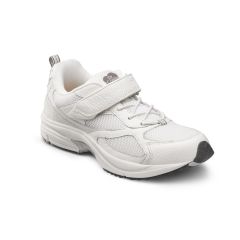
Heel Fissures
Heel fissures are caused by calloused dry skin and excessive forces acting on the bottom and back edge of the heel.
Dry skin, especially during winter, is a fairly normal condition that can be treated with skin creams. But if the crack is so deep that you see reddish colored tissue or even blood, seek medical attention. Your skin is the best defense against bacteria. Once this barrier is compromised, you run a greater risk of getting an infection.
Several conditions can cause heel fissures, including diabetes, psoriasis, thyroid changes, athlete’s foot (fungus), excessive weight and abnormal biomechanics.
How Footwear Can Help
Going barefoot or wearing open backed sandals are among the worst things you can do when you have heel fissures. Both allow the fat pad of the heel to deform, thereby opening up your fissures.
Appropriate footwear is the key to proper biomechanics and preventing the formation of fissures. Wear shoes with stable heel counters, along with inserts to reduce the pressures on your heels. Look for shoe inserts with deep heel cups to redistribute the loads more evenly across your heels, and gels or foams that will function as an artificial heel fat pad.
What Else You Can Do
- Use a pumice stone to sand away dead skin and calluses. Never cut callous tissue.
- Apply skin creams each evening before bed.
- If you are having trouble softening the callous tissue, try a petroleum-based skin softener.
- Wear socks to bed to help the lotion or ointment penetrate.
Schedule an appointment with a podiatrist or other healthcare professional for an exact diagnosis — especially if your skin isn’t responding to self-care.
Appropriate footwear is the key to proper biomechanics and preventing the formation of fissures.
We Recommend
-
View Details


Winner Plus
Men’s Athletic ShoeSpecial Price $123.75 Regular Price $165.0025% Off Save $41.25Rating:100%(14) Reviews>Lace-up cross-trainer with full top-grain leather and arch stabilization. -
View Details


Winner
Men’s Athletic ShoeSpecial Price $123.75 Regular Price $165.0025% Off Save $41.25Rating:86%(14) Reviews>Full top-grain leather trainer with arch stabilizer for improved support. -
View Details


Performance
Men’s Athletic ShoeSpecial Price $123.75 Regular Price $165.0025% Off Save $41.25Rating:85%(64) Reviews>Lightweight, cross-trainer providing arch stability, support and comfort. -
View Details


Endurance
Men’s Athletic ShoeSpecial Price $123.75 Regular Price $165.0025% Off Save $41.25Rating:89%(9) Reviews>Modern sneaker with no-tie elastic and soft leather for excellent comfort when moving.
-
View Details


Spirit
Women’s Athletic ShoeSpecial Price $123.75 Regular Price $165.0025% Off Save $41.25Rating:84%(5) Reviews>A versatile athletic shoe for women that’s lightweight, comfortable and chic. -
View Details


Victory
Women’s Athletic ShoeSpecial Price $123.75 Regular Price $165.0025% Off Save $41.25Rating:88%(10) Reviews>A Lightweight cross trainer with no-tie elastic laces for support and comfort during activities. -
View Details


Meghan
Women’s Athletic ShoeSpecial Price $49.50 Regular Price $165.0070% Off Save $115.50Rating:92%(12) Reviews>Stylish, seamless-designed sneaker with mesh uppers for all-day comfort. -
View Details


Katy
Women’s Athletic ShoeSpecial Price $49.50 Regular Price $165.0070% Off Save $115.50Rating:75%(21) Reviews>Stylish, lightweight athletic shoe with unique no-tie elastic lacing














